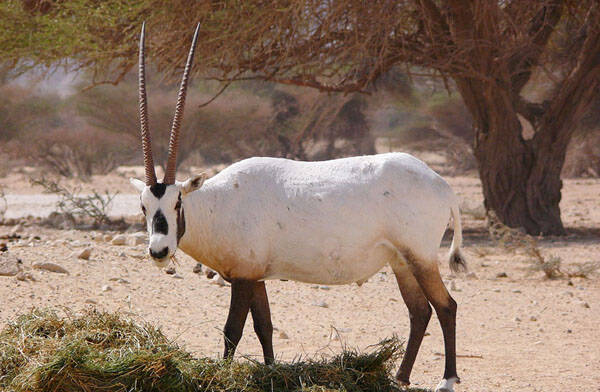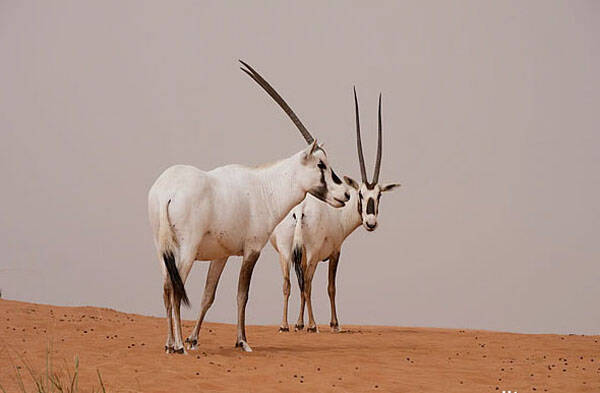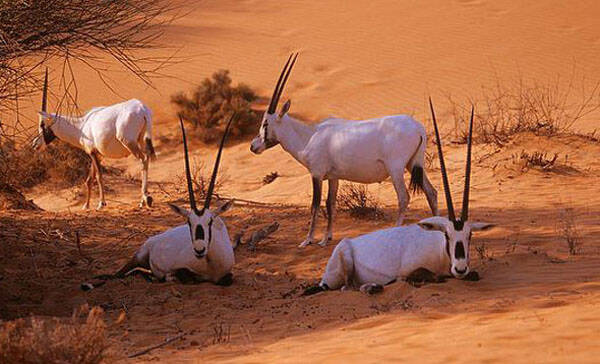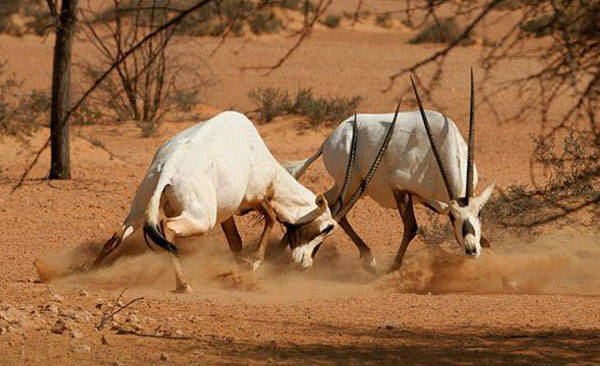Oryx leucoryx
IUCN
LCBasic Information
Scientific classification
- name:Oryx leucoryx
- Scientific Name:Oryx leucoryx,Arabian Oryx, Arabian Oryx, Arabian Oryx
- Outline:Ungulata
- Family:Artiodactyla Bovidae Oryx
Vital signs
- length:About 160 cm
- Weight:80-90kg
- lifetime:About 20 years
Feature
It is the smallest member of the genus Oryx.
Distribution and Habitat
Origin: Egypt (Sinai Peninsula), Iraq, Jordan, Kuwait, Syrian Arab Republic, United Arab Emirates, Yemen.
Reintroduction: Israel, Oman, Saudi Arabia.
Introduced: Bahrain, Qatar.
The Arabian Oryx inhabits deserts and grasslands of the Arabian Peninsula, in tropical deserts and wastelands.
Appearance
The Arabian Oryx is the smallest member of the genus Oryx, with a body length of 160 cm, a shoulder height of 81-102 cm, and an average weight of 90 kg for males and 80 kg for females. Their coat is close to snow white and shiny in the sun. The abdomen and feet are brown, with black markings between the head and neck, forehead, nose and from the horns to the eyes and mouth. Both males and females have upright ringed horns, which can be up to 68 cm long. The female horns are thinner and longer than males.
The hooves are open in a spade shape, which can contact the sand with a large surface area, making it easier to walk. The legs are brown, with white bands on the ankles, and there are brown markings on the face, forming a triangular area on the bridge of the nose, cheeks and forehead. The male has a prominent velvety Adam's apple on the throat, and the tail of both sexes is tufted, with the back half dark brown to black. The tail and legs of the young antelope are brown, and th
Details
Arabian Oryx (scientific name: Oryx leucoryx) is called Arabian Oryx in foreign language. It has no subspecies and is the smallest member of the genus Oryx.

Arabian Oryx live in groups, with groups of different sexes, 5-30 in each group, and groups of more than 100 have also appeared. They are generally not aggressive, so groups can coexist peacefully. Led by an adult male, the group has only a simple structure involving all male and female sheep over 7 months old. They will maintain visual contact with other members of the group, and other male sheep will be responsible for taking care of the members of the group and the outer female sheep. When dispersed, the male sheep will return to the place where the group was last seen until other members return. Young male sheep are solitary. Male and female sheep will use their horns to protect the resources of the territory from being stolen by outsiders.
Nocturnal, hiding in the shade of trees during the day to rest and avoid the heat, digging holes in the ground under bushes or trees to rest, and foraging activities at dusk. Arabian Oryx seems to be able to detect wind and rain. If a place is overcast, they will rush to the place hundreds of miles away to wait for the rain, and can migrate 50 kilometers overnight. The only natural enemy of the Arabian Oryx is the wolf.
In order to keep their bodies hydrated, Arabian Oryxes do not sweat to waste water, but store body heat, which means that their body temperature will continue to rise. They can withstand extremely high body temperatures of up to 46 degrees, and only when they exceed this limit will they have to take cooling measures. In comparison, camels can only withstand a body temperature of 41 degrees. At the same time, this has another advantage, making the body temperature close to the air temperature, which can reduce the heat transferred to the body by the air.

But under such high temperatures, they can still maintain their normal physiological functions. When the blood from their heart is sent to the brain from the carotid artery, it passes through the cavernous sinus in the head, where the carotid artery becomes hundreds of small arteries. The cavernous sinus also has many small arteries flowing to the heart, which come from the nasal cavity. When the venous blood flows through the nasal cavity, the heat is exhaled from the body, so the blood temperature is lower than that of the arterial blood. This can lower the body temperature by 3 degrees, so that the blood can be cooled when entering the brain, so as to avoid damage to the brain, which is most sensitive to temperature. The heat in the body will gradually be released at night, so that the temperature of the oryx can drop to 36 degrees the next day.
Their kidneys can effectively reduce the water content in urine, which is highly concentrated. However, there is still some water in its urine, and its feces must also contain a little water to be excreted. In this way, the oryx will still lose some water and still need to replenish water to prevent dehydration. When there is no water to drink, it can only replenish water through food. The grass that the oryx often eats does not contain much water. It only contains 1% water during the day. However, at night, as the temperature drops and the humidity rises, the water content of these grasses will increase by 20 times. The oryx does not eat during the day, but only eats at dusk and at night, which can ensure that the maximum amount of water in the food is absorbed.
The Arabian Oryx has another unique way of getting water. Nutrients in food, such as carbohydrates, can produce water during metabolism. Therefore, virtually all animals can indirectly get water in this way. However, this metabolic process requires the participation of oxygen, and each breath takes away water from the body. Normally, the water lost during breathing is more than the water produced during the metabolic process, which is not worth the loss. However, the Oryx has a way to change this output ratio. The method is actually very simple. At night, the Oryx starts to take deep breaths very slowly while letting the body heat stored during the day dissipate. Deep breathing can inhale more oxygen and produce more water through metabolism. At night, the air humidity is higher, and the water lost through breathing is less. In this way, the Oryx can accumulate more water in the body through deep breathing all night.

The food of the Arabian Oryx includes grass, leaves, berries, tubers, etc. This animal is extremely drought-resistant and can live healthily in high temperatures of 45-50℃ just by licking the morning dew on plants.
Arabian Oryx can mate all year round, but mainly from October to May of the following year. One male mates with multiple females. During the breeding season, males fight each other for mating rights. The gestation period of females is about 8-9 months, and only one cub is born per litter. The lactation period is about 3-5 months. The cub lives with the mother for about one year before becoming independent. It reaches sexual maturity at 1-2 years old and has a maximum lifespan of 20 years.
Due to human factors such as habitat destruction and overhunting, wild Arabian Oryx became extinct in 1962. In the 1950s, countries had already started artificial breeding. Arabia, Saudi Arabia, the United Arab Emirates, Amman, Jordan, and Yemen have all established corresponding protected areas. The reintroduction program began in Oman in early 1982. In 1982, the United States returned some captive individuals to the Arabian Peninsula for release into the wild. The total number only grew to 400-600. The number in Saudi Arabia increased from 400 in 1997 to 700 in 2003. The population in Israel also increased. In 2007, the United Arab Emirates released 100 Arabian Oryx in Abu Dhabi, with the goal of introducing 500 by 2012. Phoenix Zoo is also contributing to the conservation of Arabian Oryx. In 1962, the first program to breed Arabian Oryx was launched. Initially, there were only 9, and now there are more than 200. These captive Arabian Oryx were sent to other zoos to start new groups. By 1990, their number exceeded 1,300, including 112 captives that were returned to the wild.

On June 28, 2007, Oman's Arabian Oryx Reserve became the first area to be removed from the UNESCO World Heritage List. The reason was that the Omani government's oil exploitation drastically reduced its habitat by 90%. The Arabian Oryx has successfully restored its natural habitat in the Arabian Peninsula, downgrading from endangered to vulnerable species. The International Union for Conservation of Nature (IUCN) has changed the status of the Oryx from "endangered" to "vulnerable" in the latest Red List of Threatened Species. For the first time, the continuation of the species did not develop in the direction of endangered to extinction, but was successfully reversed.
Protect wild animals and eliminate game.
Maintaining ecological balance is everyone's responsibility!








